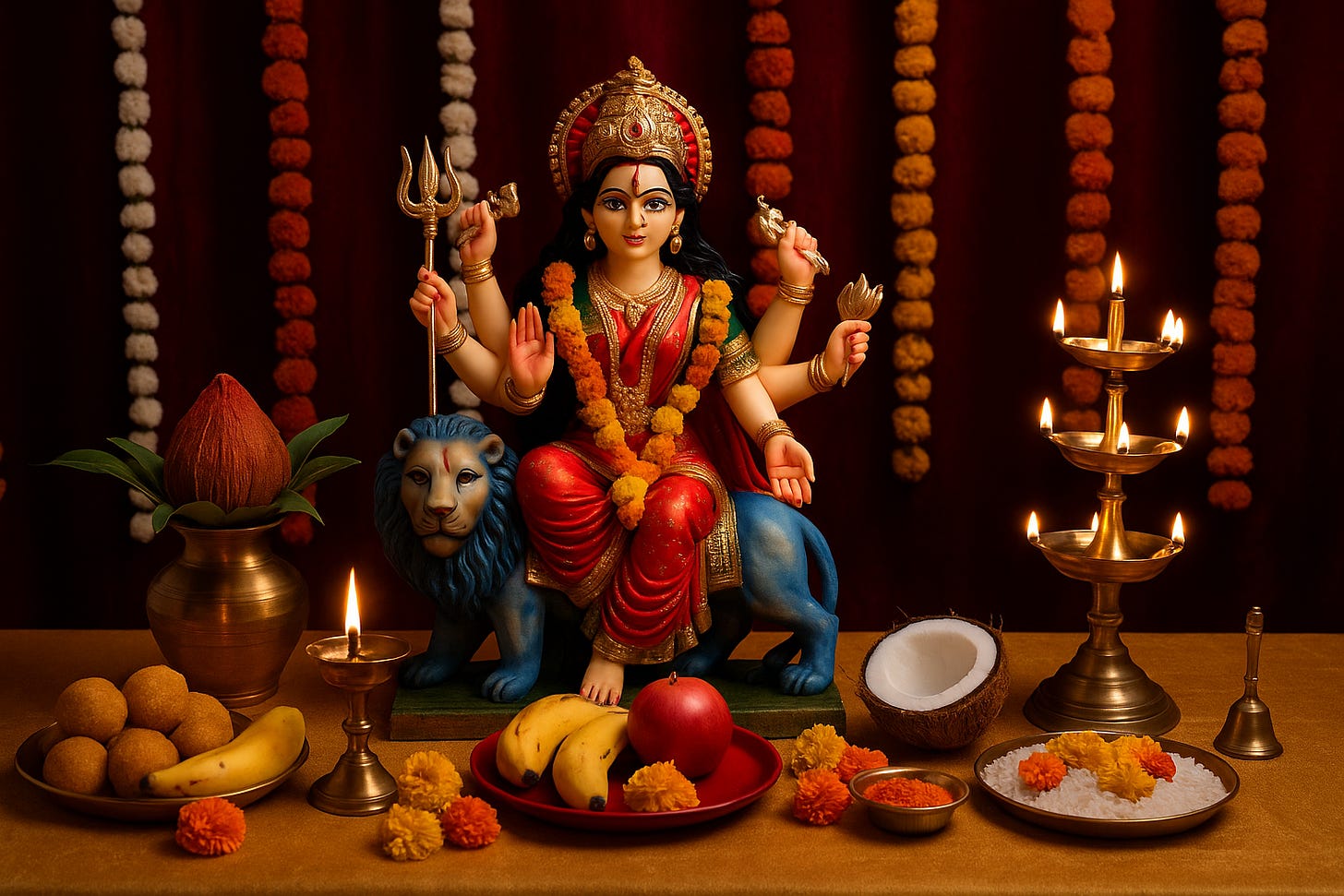Durga Puja and Navratri are among the most spiritually powerful times of the year, dedicated to the worship of Maa Durga and her nine divine forms (Navadurga). While grand pandals and temple rituals create festive vibes outside, equally meaningful pujas can be performed at home. These home-based rituals help invoke the blessings of the Goddess, bring harmony to the household, and remove obstacles caused by planetary doshas.
Here’s a detailed guide:
1. Kalash Sthapana (Ghatasthapana)
How to Do It:
Place a clean pot (Kalash) filled with water, five mango leaves around its mouth, and a coconut wrapped in red cloth on top.
Position it on a small mound of soil where barley or wheat seeds are sown.
Invoke Maa Durga into the Kalash by chanting “Om Aim Hreem Kleem Chamundayai Vichche”.
Significance:
The Kalash represents the universe and fertility, symbolizing abundance and life energy.
As the barley sprouts grow during Navratri, they reflect prosperity, growth, and good health in the family.
Doshas It Helps With:
Financial difficulties & stagnation (Dhan Dosha).
Vastu-related obstacles, especially where energy flow at home is blocked.
2. Daily Maa Durga Puja
How to Do It:
Place Maa Durga’s idol or image on a clean altar with a red or yellow cloth.
Light a diya and incense every morning and evening.
Offer red flowers, fruits, and sweets (bhog).
Chant Durga Chalisa or the mantra “Om Dum Durgaye Namah” 108 times daily.
Significance:
Daily prayers keep negative energy away and strengthen positive vibrations in the home.
Helps create a disciplined spiritual routine and deepens family bonding through collective prayer.
Doshas It Helps With:
Shakti Peeda Dosha (lack of energy or vitality).
Graha Dosh, especially weak Moon or Venus, which impacts peace and relationships.
3. Navadurga Puja (Nine Forms of Devi)
Each day of Navratri is dedicated to one form of Goddess Durga. Worshipping each form with her associated color, flowers, and offerings invites specific blessings.
How to Do It:
Dedicate each day to one form of Maa Durga.
Use the prescribed color of the day (cloth, flowers, attire).
Recite the mantra of that particular form.
Offer her favorite prasad (like ghee, honey, fruits, or kheer).
Significance:
Ensures blessings for wealth, health, knowledge, strength, and protection.
Balances all nine aspects of Shakti in your life.
Doshas It Helps With:
Navagraha Doshas (imbalances of the nine planets).
Kaal Sarp Dosha, when worship done with proper mantra chanting.
4. Kumari Puja (Kanya Pujan)
How to Do It:
On Ashtami (Day 8) or Navami (Day 9), invite little girls (ages 2–10) as embodiments of Maa Durga.
Wash their feet, apply kumkum and turmeric, tie red sacred thread (kalava), and offer flowers.
Serve them traditional food (puri, chana, halwa) and give small gifts.
Significance:
Little girls represent Shakti in her purest form. Worshipping them ensures prosperity, purity, and blessings for children at home.
Doshas It Helps With:
Putra Dosha (problems related to progeny/children).
Family disharmony caused by afflictions of Mars or Rahu.
5. Reciting Durga Saptashati or Chalisa
How to Do It:
The Durga Saptashati (Devi Mahatmyam) is divided into 13 chapters and can be read over 9 days.
Alternatively, recite the Durga Chalisa daily for simplicity.
Perform the recitation after lighting a lamp and offering flowers.
Significance:
Considered one of the most powerful scriptures, it invokes Maa Durga’s victory over Mahishasura.
Strengthens mental resilience, removes fears, and brings confidence.
Doshas It Helps With:
Shani Dosha (Saturn afflictions causing obstacles and delays).
Chandra Dosha (emotional instability, anxiety).
6. Satvik Food & Fasting Rituals
How to Do It:
Follow a satvik diet (no onion, garlic, alcohol, or non-veg).
Many devotees observe partial or full fasts, eating fruits, milk, and vrat-friendly foods (sabudana, kuttu atta, singhara atta).
Break the fast in the evening with bhog offered to Maa Durga.
Significance:
Fasting detoxifies the body and mind, aligning you with spiritual energy.
Teaches self-discipline and devotion.
Doshas It Helps With:
Health-related doshas, particularly linked to weak Sun or weak Jupiter.
7. Aarti & Akhand Jyot
How to Do It:
Perform aarti every morning and evening with camphor, bell, and conch.
Some families light an Akhand Jyot (continuous lamp) for the entire nine days.
Chant “Ya Devi Sarva Bhuteshu” during the aarti.
Significance:
The jyot represents the eternal light of Shakti.
Keeps away evil energies and negativity from the home.
Doshas It Helps With:
Pitru Dosha (ancestral issues).
Rahu-Ketu Dosha, linked to negative energies.
8. Vijayadashami Ritual (Symbolic Visarjan)
How to Do It:
On the 10th day (Dussehra), perform a small visarjan at home.
Offer flowers, betel leaves, and sweets, and symbolically immerse them in water.
Pray for Maa Durga to bless and return next year.
Significance:
Symbolizes victory of good over evil.
Ensures that Maa Durga’s blessings stay in your household throughout the year.
Doshas It Helps With:
Enemy-related doshas (Shatru Dosha).
Helps overcome court cases, conflicts, and personal struggles.
Benefits of Doing Home Pujas During Navratri
Spiritual Growth: Deepens devotion and strengthens connection with Maa Durga.
Wealth & Prosperity: Brings financial stability, removes debts, ensures abundance.
Health & Vitality: Protects against illness and energizes family members.
Harmony & Peace: Reduces conflicts, strengthens family bonding.
Protection: Safeguards the home from negative energies and evil influences.
✨ In essence, Navratri and Durga Puja home rituals are not just about devotion but also about healing energies, prosperity, and cosmic alignment. By performing these pujas sincerely, you invite Maa Durga into your home, who blesses you with Shakti (power), Buddhi (wisdom), and Sampatti (wealth).


